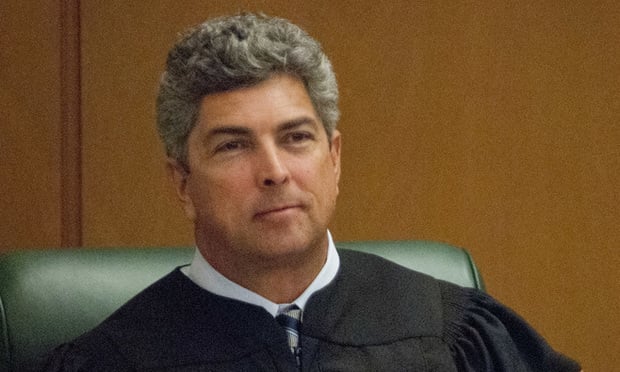Ga. Justices Toss Punitive Damages Against Surety for Conservator's Theft
The Georgia Supreme Court ruled that punitive damages a probate judge entered against the conservator could not be levied against the insurance company that provided the surety bond.
May 11, 2018 at 01:58 PM
4 minute read

The Georgia Supreme Court has ruled the issuer of a surety bond is not responsible for a $150,000 punitive damages award a probate court levied against it and the conservator of an incapacitated woman after the judge determined the conservator had looted the funds.
The finding overturns a Georgia Court of Appeals ruling that left Ohio Casualty Co., which served as the surety for the conservator, on the hook not only for $167,000 in misappropriated funds, but jointly and severally liable for $150,000 in punitive damages as well.
“Our argument was that there's never been a case in Georgia where a surety was assessed for punitive damages unless the statute calling for the bond—which are required by law—specified that penalties were available,” said Bovis, Kyle, Burch & Medlin partner Tim Burson.
“These bonds are essentially guarantees that guardians and estate administrators will fulfill their fiduciary duties,” he said. “Probate cases like this are ripe for people who don't just mishandle the estate's assets, but get sticky fingers and actually take money.”
If the lower courts' rulings had stood, such relatively pricey bonds could have been more difficult for sureties to write, he said.
“These bonds have become among the hardest to get, and they're getting harder. To conceptualize that we could be responsible for unlimited punitive damages is one of those things that make us take a second look,” said Burson, who represented Ohio Casualty Insurance and parent Liberty Mutual, along with firm partners William Bryant and John Burch.
The attorney for the current conservator, Richard Neville of Cummings' Neville & Cunat, declined to discuss the case.
Craig Oakes of Lawrenceville's Bryant & Oakes, who represents the now-replaced conservator, Emanuel Gladstone, said the decision “speaks for itself.”
As detailed in the justices' ruling and other documents, the case began in 2015 when Forsyth County Probate Court Judge Lynwood Jordan Jr. appointed Gladstone to be the conservator for his wife, Jacqueline, who suffered from dementia.
Jordan set a $430,000 bond that Ohio Casualty posted and appointed an attorney to oversee the management of the conservatorship.
Several months later, the attorney raised concerns that Emmanuel Gladstone had not provided a proper asset management plan and was making unapproved expenditures.
Jordan removed Gladstone and appointed another conservator. Following a hearing, Jordan issued an order finding that—while some of Emmanuel Gladstone's expenditures were justified—there were improper withdrawals from the account, including $80,000 he withdrew just before Jordan replaced him.
Jordan ordered Gladstone and Ohio Mutual to repay $167,000 and, finding Gladstone breached his fiduciary duty, another $150,000 in joint and several punitive damages.
Ohio Casualty immediately paid the $167,000, Burson said, then both Gladstone and Ohio Casualty filed separate appeals with the Georgia Court of Appeals, with the surety challenging only the punitive damages awarded against it.
In March 2017, the appeals court upheld both the actual and punitive damages award against Gladstone and Ohio Casualty.
In the section dealing with Ohio Casualty's appeal, the appeals court found that, while the relevant law “requires that a conservator's bond 'be in a value equal to the estimated value of the estate,' if it is secured by a licensed commercial surety, it does not necessarily follow, as the surety argues, that recovery is limited to actual loss.”
“Because Gladstone failed to discharge all of his duties faithfully, both he and the surety are jointly and severally liable up to the amount of the bond,” it said.
But Justice Michael Boggs, writing for the unanimous Supreme Court, said the law contained no such provision. Justice Nels Peterson did not participate.
“We find no authority in the conservator's bond statutes authorizing punitive damages against the surety and the surety is not engaged in any wrongful conduct, so the punishment and deterrent purpose of punitive damages would be entirely misplaced,” Boggs wrote.
The opinion cited a 1941 ruling, Nat. Surety Corp. v. Gatlin, 192 Ga. 293, “which provided that the measure of damages recoverable in actions on official bonds for the misconduct of the officer was, 'unless otherwise specially enacted,' the amount of the injury actually sustained.'”
Burson said the opinion still leaves Gladstone open for efforts by Ohio Casualty to recoup the $167,000 it paid, and for the current conservator to also pursue him for the punitive damages.
This content has been archived. It is available through our partners, LexisNexis® and Bloomberg Law.
To view this content, please continue to their sites.
Not a Lexis Subscriber?
Subscribe Now
Not a Bloomberg Law Subscriber?
Subscribe Now
NOT FOR REPRINT
© 2025 ALM Global, LLC, All Rights Reserved. Request academic re-use from www.copyright.com. All other uses, submit a request to [email protected]. For more information visit Asset & Logo Licensing.
You Might Like
View All
Sanctions Order Over Toyota's Failure to Provide English Translations of Documents Vacated by Appeals Court
4 minute read
Second Circuit Upholds $5M Judgment Against Trump in E. Jean Carroll Case
4 minute read
'Paragraph V Displaced Lathrop': High Court Mulls Sovereign Immunity Waiver Disputes
7 minute read
11th Circuit Revives Project Veritas' Defamation Lawsuit Against CNN
Trending Stories
Who Got The Work
J. Brugh Lower of Gibbons has entered an appearance for industrial equipment supplier Devco Corporation in a pending trademark infringement lawsuit. The suit, accusing the defendant of selling knock-off Graco products, was filed Dec. 18 in New Jersey District Court by Rivkin Radler on behalf of Graco Inc. and Graco Minnesota. The case, assigned to U.S. District Judge Zahid N. Quraishi, is 3:24-cv-11294, Graco Inc. et al v. Devco Corporation.
Who Got The Work
Rebecca Maller-Stein and Kent A. Yalowitz of Arnold & Porter Kaye Scholer have entered their appearances for Hanaco Venture Capital and its executives, Lior Prosor and David Frankel, in a pending securities lawsuit. The action, filed on Dec. 24 in New York Southern District Court by Zell, Aron & Co. on behalf of Goldeneye Advisors, accuses the defendants of negligently and fraudulently managing the plaintiff's $1 million investment. The case, assigned to U.S. District Judge Vernon S. Broderick, is 1:24-cv-09918, Goldeneye Advisors, LLC v. Hanaco Venture Capital, Ltd. et al.
Who Got The Work
Attorneys from A&O Shearman has stepped in as defense counsel for Toronto-Dominion Bank and other defendants in a pending securities class action. The suit, filed Dec. 11 in New York Southern District Court by Bleichmar Fonti & Auld, accuses the defendants of concealing the bank's 'pervasive' deficiencies in regards to its compliance with the Bank Secrecy Act and the quality of its anti-money laundering controls. The case, assigned to U.S. District Judge Arun Subramanian, is 1:24-cv-09445, Gonzalez v. The Toronto-Dominion Bank et al.
Who Got The Work
Crown Castle International, a Pennsylvania company providing shared communications infrastructure, has turned to Luke D. Wolf of Gordon Rees Scully Mansukhani to fend off a pending breach-of-contract lawsuit. The court action, filed Nov. 25 in Michigan Eastern District Court by Hooper Hathaway PC on behalf of The Town Residences LLC, accuses Crown Castle of failing to transfer approximately $30,000 in utility payments from T-Mobile in breach of a roof-top lease and assignment agreement. The case, assigned to U.S. District Judge Susan K. Declercq, is 2:24-cv-13131, The Town Residences LLC v. T-Mobile US, Inc. et al.
Who Got The Work
Wilfred P. Coronato and Daniel M. Schwartz of McCarter & English have stepped in as defense counsel to Electrolux Home Products Inc. in a pending product liability lawsuit. The court action, filed Nov. 26 in New York Eastern District Court by Poulos Lopiccolo PC and Nagel Rice LLP on behalf of David Stern, alleges that the defendant's refrigerators’ drawers and shelving repeatedly break and fall apart within months after purchase. The case, assigned to U.S. District Judge Joan M. Azrack, is 2:24-cv-08204, Stern v. Electrolux Home Products, Inc.
Featured Firms
Law Offices of Gary Martin Hays & Associates, P.C.
(470) 294-1674
Law Offices of Mark E. Salomone
(857) 444-6468
Smith & Hassler
(713) 739-1250






